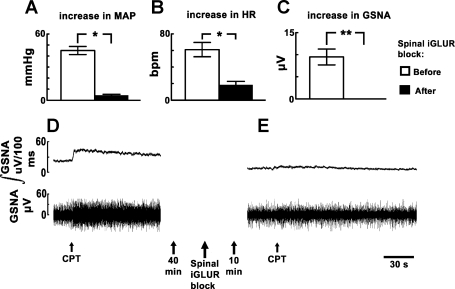Fig. 4.
Effect of spinal iGLUR blockade on CPT responses. A and B: initial increases in MAP and HR in response to CPT were 45.0 ± 3.7 mmHg and 61.0 ± 8.6 beats/min, respectively (n = 10). After the blockade of spinal iGLURs, by intrathecal injections of NBQX (2 mM, 10 μl) and d-AP7 (5 mM, 10 μl), the increases in MAP and HR in response to CPT were 4.5 ± 0.8 mmHg and 18.5 ± 4.2 beats/min, respectively; both MAP and HR responses to CPT were significantly (*P < 0.001) reduced, but the reduction in the CPT-induced increases in MAP (90%) was much greater than the reduction in HR increases (69.67%). C: increase in greater splanchnic nerve activity (GSNA) in response to CPT before the blockade of spinal iGLURs was 9.5 ± 1.8 μV. After the blockade of spinal iGLURs, application of CPT failed to elicit an increase in GSNA (**). D: integrated GSNA (trace on top) and raw GSNA (trace on bottom). The integrated and raw GSNA were increased rapidly after CPT. The onset of the increase in GSNA was immediate, and the peak response was observed within 10–15 s. E: later (40 min), intrathecal injections of NBQX (2 mM) and d-AP7 (5 mM) caused a decrease in GSNA. Later (10 min), the response to CPT was blocked.

